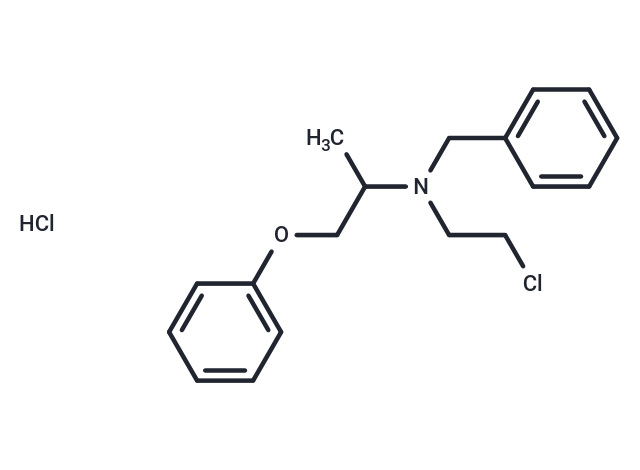 Your shopping cart is currently empty
Your shopping cart is currently empty

Phenoxybenzamine hydrochloride (NCI-c01661) is the hydrochloride salt form of phenoxybenzamine, a synthetic, dibenzamine alpha-adrenergic antagonist with antihypertensive and vasodilatory properties. Phenoxybenzamine non-selectively and irreversibly blocks the postsynaptic alpha-adrenergic receptor in smooth muscle, thereby preventing vasoconstriction, relieving vasospasms, and decreasing peripheral resistance. Reflex tachycardia may occur and may be enhanced by blockade of alpha-2 receptors which enhances norepinephrine release. Phenoxybenzamine is reasonably anticipated to be a human carcinogen.

| Pack Size | Price | USA Warehouse | Global Warehouse | Quantity |
|---|---|---|---|---|
| 500 mg | $29 | In Stock | In Stock | |
| 1 g | $42 | - | In Stock | |
| 1 mL x 10 mM (in DMSO) | $29 | In Stock | In Stock |
| Description | Phenoxybenzamine hydrochloride (NCI-c01661) is the hydrochloride salt form of phenoxybenzamine, a synthetic, dibenzamine alpha-adrenergic antagonist with antihypertensive and vasodilatory properties. Phenoxybenzamine non-selectively and irreversibly blocks the postsynaptic alpha-adrenergic receptor in smooth muscle, thereby preventing vasoconstriction, relieving vasospasms, and decreasing peripheral resistance. Reflex tachycardia may occur and may be enhanced by blockade of alpha-2 receptors which enhances norepinephrine release. Phenoxybenzamine is reasonably anticipated to be a human carcinogen. |
| In vitro | The IC50 (100 nM) derived from the blockade of [3H]yohimbine binding by Phenoxybenzamine hydrochloride is significantly less than the IC50 (550 nM) for the corresponding reversal by Phenoxybenzamine hydrochloride of the effects of norepinephrine on cyclic AMP accumulation[1]. Phenoxybenzamine hydrochloride (50 nM) in conbination with Phenoxybenzamine hydrochloridetolamine (1000 nM) enhances Phenoxybenzamine hydrochlorideylephrine-induced contraction compared with pretreatment with Phenoxybenzamine hydrochloride (50 nM) alone in endothelium-intact aortae. Combined treatment with either dexmedetomidine (300 or 1000 nM) and Phenoxybenzamine hydrochloride (50 nM) or Phenoxybenzamine hydrochloridetolamine (1000 nM) and Phenoxybenzamine hydrochloride (50 nM) enhance Phenoxybenzamine hydrochlorideylephrine-induced contraction compared with Phenoxybenzamine hydrochloride alone (50 nM). In addition, combined treatment with Phenoxybenzamine hydrochloridetolamine and Phenoxybenzamine hydrochloride enhances Phenoxybenzamine hydrochlorideylephrine-induced contraction compared with dexmedetomidine (1000 nM) and Phenoxybenzamine hydrochloride combined treatment. Combined treatment with high concentrations of dexmedetomidine (1000 nM) and Phenoxybenzamine hydrochloride enhances Phenoxybenzamine hydrochlorideylephrine-induced contraction compared with combined treatment with low concentrations of dexmedetomidine (300 nM) and Phenoxybenzamine hydrochloride[2]. |
| In vivo | Phenoxybenzamine hydrochloride (20 nM, s.c.) effectively suppresses the tumorigenesis of glioma cells in mice and the cell density in Phenoxybenzamine hydrochloride-U87 mg xenografts decreases significantly[3]. Phenoxybenzamine hydrochloride (1 mg/kg, i.v.) treated rats shows significant improvements in NSS and foot fault scoring[4]. |
| Cell Research | Phenoxybenzamine hydrochloride is dissolved in DMSO. After cytometry, 1×3 cells are implanted in a 96-well plate in 100 μL DMEM supplemented with 10 % FBS. Ten microliter (10 % of the total volume) WST-1 (Water Soluble Tetrazolium) is added to cells and incubated at 37°C for 30 min before colorimetric assay with 450 nm excitation and 630 nm emission at 24 h intervals up to 96 h. The mean fluorescence value is counted, and the cell number is determined using the standard curve. |
| Synonyms | Phenoxybenzamine HCl, NSC 37448, NCI-c01661 |
| Molecular Weight | 340.3 |
| Formula | C18H23Cl2NO |
| Cas No. | 63-92-3 |
| Smiles | Cl.CC(COc1ccccc1)N(CCCl)Cc1ccccc1 |
| Relative Density. | no data available |
| Storage | Powder: -20°C for 3 years | In solvent: -80°C for 1 year | Shipping with blue ice/Shipping at ambient temperature. | ||||||||||||||||||||||||||||||||||||||||
| Solubility Information | Ethanol: 63 mg/mL (185.13 mM), Sonication is recommended. H2O: 14 mg/mL (41.14 mM), Sonication is recommended. DMSO: 55 mg/mL (161.62 mM), Sonication is recommended. | ||||||||||||||||||||||||||||||||||||||||
| In Vivo Formulation | 10% DMSO+40% PEG300+5% Tween 80+45% Saline: 2 mg/mL (5.88 mM), Sonication is recommended. Please add the solvents sequentially, clarifying the solution as much as possible before adding the next one. Dissolve by heating and/or sonication if necessary. Working solution is recommended to be prepared and used immediately. The formulation provided above is for reference purposes only. In vivo formulations may vary and should be modified based on specific experimental conditions. | ||||||||||||||||||||||||||||||||||||||||
Solution Preparation Table | |||||||||||||||||||||||||||||||||||||||||
H2O/DMSO/Ethanol
DMSO/Ethanol
| |||||||||||||||||||||||||||||||||||||||||
| Size | Quantity | Unit Price | Amount | Operation |
|---|

Copyright © 2015-2025 TargetMol Chemicals Inc. All Rights Reserved.